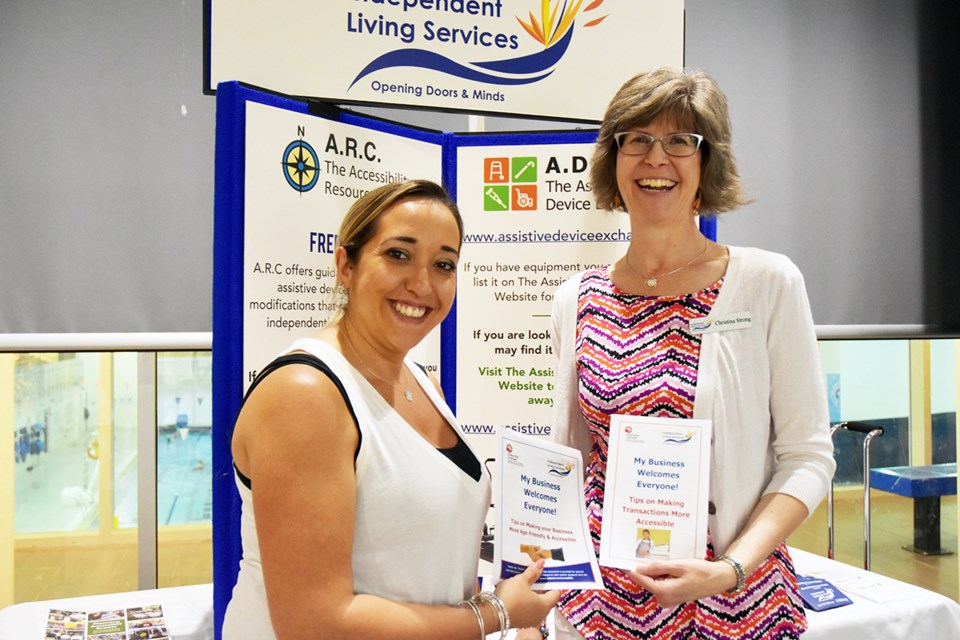After an autoimmune disease damaged Christina Strong’s vocal chords and put her in a wheelchair, she said the obstacles kept coming after she left the hospital.
Looking forward to lunch at a restaurant, she said she felt completely ignored by servers, who directed all their conversation to her mother.
“I remember feeling invisible. I remember feeling an obstacle,” she said. She did not return to that restaurant.
Now a public awareness co-ordinator with Independent Living Services of Simcoe County and Area, she ran a workshop in Bradford West Gwillimbury this week as part of National Accessibility Awareness Week.
She had a message for employers: make your businesses accessible.
The workshop, My Business Welcomes Everyone, held at the Bradford West Gwillimbury Leisure Centre, not only gave businesses a rationale for making inclusion a priority but outlined some steps to achieve accessibility — starting with customer service.
While four per cent of customers complain about a negative experience, she said, 91 per cent of dissatisfied customers will never return to that business. Not only that, they will pass on their negative news to family members and friends.
To combat this, employers can train staff to be sensitive and to offer assistance, ensure signage is accurate and legible, update signage to universal symbols instead of words, and improve lighting for the visually impaired.
All of these are inexpensive means of improving the business experience for people with disabilities, Strong said.
Currently, one in seven Ontarians has a disability, according to Statistics Canada. That is 3.8 million people in the province, making persons with disabilities “the largest minority group within Ontario,” Strong said.
And as the population ages, that number will increase to one in five people by 2036, she said.
As well, aging baby boomers account for 33 per cent of the population, but 55 per cent of discretionary income, Strong said.
They tend to be healthy, interested in travel, and 90 per cent of them own their own home — a huge multi-billion dollar market for any business prepared to step up, she said.
BWG Coun. Raj Sandhu said the BWG Accessibility Advisory Committee, of which he is chair, offers accessibility assessments for local businesses to help them identify barriers and to comply with the Accessibility for Ontarians with Disabilities Act, but few employers have taken advantage of the option.
There is a level of distrust, as if the committee would “spy” on local businesses in an adversarial way, he said.
“We have no teeth to get them to do things,” he said, adding the committee’s only goal is to make businesses more aware of barriers and alternatives.
There are several ways to overcome barriers, Strong said. These include wider aisles in stores, keeping the aisles clear of blockages and displays, ensuring entrances are wide enough to accommodate wheelchairs, cutting down a portion of counters to provide a wheelchair-height view.
While they may require a budget, Strong said, she suggested business owners investigate government grants, talk with landlords about possible improvements, and think outside the box.
“We’re always going to have buildings that are outdated, buildings that are historic,” but there might be other options, such as providing online shopping and a delivery service, she said.
“Be creative about solutions. It really does show good corporate citizenship. The right thing to do is to make everyone feel welcome.”
Strong is still disabled, although she shows few outward signs.
“There’s a lot of people out there with invisible disabilities,” such as heart conditions, chronic pain or fatigue, she said.
To be inclusive and accessible, businesses should take the same approach with everyone: “Ask that simple question: How can I help?”
“Loyal customers are worth up to 10 times as much as their first purchase. That’s why you should care.”
For more information on making businesses and homes accessible, or to arrange for an accessibility workshop presentation, contact Independent Living Services of Simcoe County & Area at 1-800-465-1133 or [email protected].
